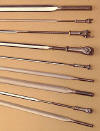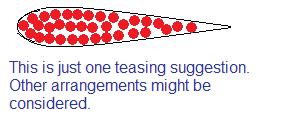|
Old Forum Posts for forum called KiteLines |
| Kites involve wing set, line or tether set, and resistive set that could also be a wing set. This discussion group aims to focus on the lines used in the tether set, including subsets of lines for bridles and other kite system operations. Lines for tiny kites or huge sky meshes of wings for travel or energy production are in focus here. Line handling, inspection, use, supply, termination, manufacturing, failure mode, reeling lines, reeling effects on lines, line challenges, knots in lines, hockles, illuminated lines, etc. are fair topics. Staying on a thread's topic makes for a better searchable result. |
|
M50: Exceptionally Wide Kite-System Tether Segments Explore the world of tether segments in kite systems that are exceptionally wide relative to the projection to the wind. Such wide segments might be tag-lined to ground or to branched sub-kite systems within the global macro-kite system involved. Many format choices for the segment might be explored for various reasons. |
| M49: The EP Register record is with an interested offer of data: https://register.epo.org/application?number=EP11741170 |
| M48: Tether for renewable energy systems WO2012013659A1 |
|
M47: Tether Dynamics Start: http://energykitesystems.net/HilaryCostello/index.html http://www.energykitesystems.net/Tethers/index.html http://www.energykitesystems.net/WPGA/Members/Tethers/index.html http://www.energykitesystems.net/TetherHandling/index.html http://www.energykitesystems.net/TwistMethod/index.html http://www.energykitesystems.net/CoopIP/SelfLiftingTethers.html http://www.energykitesystems.net/Tethers/SmartTethers/index.html Faust tail-control tether systems (not linked yet) |
|
M46:
http://www.energykitesystems.net/DavidsonTechnology/index.html Study the tether matters in the patent application. What is old? What might be novel? |
|
M45: Dave Santos offers the fuel content of kite system for doing further
work: Kite as Energy Storage Device |
| M44: Anti-kinking transmission and guiding system for running cables US 8511645 B2 |
|
M43: What to do with de-commissioned kite lines? Recycle them? How? Second safe uses? What? A kite line may become unworthy for a certain kiting use for a number of reasons. Those reasons result in de-commissioning a line for a specific use. Those reasons are invited to be explored carefully. Labeling a line as to its condition and readiness or unreadiness for a certain use can make a huge difference in a kite system operation. One has a line; is it safe to use now for a certain operation? Without knowing the history of the line including current certified testing, one may be risking wrong use for a specific line. Keeping lines out of wrong uses is an important safety matter. But once the line is labeled for recycling or secondary use, what are some of the options? What are the engineering specifics of secondary use or recycling of line? |
|
M42: High-speed faired towline
US 4655155
Filing date: Jan 28, 1985 Issue date: Apr 7, 1987 Reece Folb and Shelton M. Gay, Jr |
|
M41: Patent number: US
3304364 Filing date: Jan 25, 1965 Issue date: Feb 14, 196 CONDUCTING TOW LINE STRUCTURE, Alexander C. Hetherington |
|
M40: STREAMLINED CONDUCTOR CABLE by E. C. CRAIG, Patent number: US 2435956 Filing date: Dec 9, 1942. Issue date: Feb 17, 1948. |
|
M39: Fairing for tow-cables by Neville E. Hale. Patent number: US
4700651 Filing date: Sep 26, 1984. Issue date: Oct 20, 1987. Discuss this and all earlier faired tethers. |
|
M38: Lines in fluids may be faired; however, fairing may bring "kiting" or
fluttering or both. ============================= Composite cable fairing by Robert R. Holcombe, Steven G. Parks, Patrick M. Broganl Patent number: US 4542708. Filing date: Jan 6, 1984. Issue date: Sep 24, 1985 Discuss this and all findable earlier and later cable-fairing patents. |
|
M37: Line surface treatments, uses, textures, Shape Texture Radiance Reflection Sound Color Pixelized messages, text, video, Fine art Video Changing colors Sensors Conductive segments for counting length Markers for counting length Marker for splice area Markers for visibility Electrically conductive surface Streamlined shape Black for converting sunlight to warmth White for cool line Water evaporation from the line Spray water or other chemicals from the line Collect water from air Mirror finish Rough textures for various reasons ??? |
|
M36: Adjustable strap for a kite line by Daniel Prentice Patent number: US 6056243. Filed: Dec 31, 1997. Issued: May 2, 2000 Discuss. |
| M35: Line wear. Self-powered sensors developed for monitoring aircraft integrity |
|
M34: Line wear. Structural stress sensor able to repair itselfb "The self-repairing stress sensor is able to rebuild its polymer filament using liquid resin and a UV light beam |
|
M33: Wire. Wires of many sorts are used
in kite systems. Selection of wire for the specific kite-system function
challenges crafters and engineers.
http://en.wikipedia.org/wiki/Stranded_wire Discuss. Start:
|
|
M32: Knot Break Strength vs Rope Break Strength http://www.caves.org/section/vertical/nh/50/knotrope.html
Knot
Break Strength vs Rope Break Strength |
M31: Line wear
Some related links, so far: |
M30: Ice on ropes
|
|
M29: Washing Dyneema line after saltwater use Want to wash line? What ways are there to wash lines? Discussion is invited.
How much in a system will washing of lines make a difference in cost,
safety, enjoyment, effectiveness?
Here is one method: |
| M28: Towing with ropes with Dyneema http://youtu.be/EIPixRCYKv8 Discuss. |
|
M27: Atlantic Braids.
http://youtu.be/cYEMT5avIUk
Dyneema rope VS steel rope - strength test - break test Discuss. |
|
M26: A braiding line splicing
http://youtu.be/Iacr1totn8A
Discuss. Caution: Shown splice is for braiding. What specific lines and lengths into each part would be needed to avoid separation? What bonding enhancements might be considered? Whipping? Serpentine reentries? Load tests on each change? Find studies for testing the splice method for tensional uses. |
| M25: Dyneema rope VS steel rope - strength test - break test Discuss |
|
M24: Simple Splicing in
Spectwelve Dyneema Core with Push Fids
Video: 4:02 Load testing results are invited. Discuss. Feed the rope through a gap in the braid; use a fid. Etc. For the second loop, a larger fid will be needed. Discuss. Load tests. What thimble? |
|
M23:
Links for ropework (other links are invited for this thread)
|
|
M22: splicing spectra, denema, or other loose braided cords http://youtu.be/ajc21RsClh0 Discuss the video. What stresses and strains occur on the shown locking method? |
M21: This thread welcomes Spectra notes.
|
|
M20: Watercraft having a kite-like element by Stephan Wrage.
Patent number: US8056490
Filing date: Mar 17, 2010. Discuss claims, especially in comparison to his other patents and pending applications. |
|
M19: This thread invites notes on line safety.
Starting: June 3, 2011.
It turned out that the cable used was of the correct dimensions--but
the specification was different--although this was not obvious by
just looking at it. The correct cable had a nylon core around which the
wire rope was laid and a dry makeup. The one used had oil impregnated into
the makeup which, when the brake was applied, provided little stopping
friction . |
|
M18: Wire rope splicing.
http://tinyurl.com/WireRopeSpliceGENLINKimages
General images. Following holding pages may lead to valuable documents. |
|
M17:
What for kitelines may be learned from Talurit ?
I sent request for copy of their Ferrule Securing Instructions. |
|
M16: Study of wire rope splicing techniques is invited. Links,
comments toward use in kite line assemblies, etc.
========== Wire rope manual ... has a thread started in this group wherein the manual are some splicing notes. ================= Comparison of life and failure modes for spliced terminations versus compressed sleeves and other methods form topics for discussion. Niche applications for each? Best for what applicaiton? Cares and tips? Inspection? Tracking status of an installation. Experience reports? |
|
M15: Soldered train of whippings and whipped stops Joe, Your description seems OK but the method takes time and is not kind on the fingers either. Tony |
|
M14:
The
method of this topic thread needs study and testing before using the
method in any life-keeping situations. ============================================== Method under study: Prentice early HG cable termination |
|
M13: Re: Streamlined shrouds of multiple cables http://www.flyingwires.com/html/inventory.html Vibration Will streamlining help kite hang glider flying wires? Relaxation and tension cycles might preclude use of rods for kite hang glider flying lines. How steady is the flow beneath the wing at the flying wires? How could testing be done to see the benefit level of streamlining the flying lines in kite hang gliders? |
 M12:
Re: Streamlined shrouds of multiple cables M12:
Re: Streamlined shrouds of multiple cableshttp://www.steenaero.com/Images/Products/flying_wires_collection_ends_small_horiz.jpg
What are some wind tunnel studies of streamlined cables or thin rods? |
|
M11: Carbon lines.
Carbon fiber, carbon rope, carbon string, carbon cable, carbon fiber tow,
Links are welcome about aspects of carbon lines |
|
M10:
UHMWPE Ultra-high-molecular-weight polyethylene
Aspects?
|
| M9: had been deleted. |
|
M8: Wire rope: galvanized versus stainless steel Depending on the kite application, this thread invites study of Wire rope: galvanized versus stainless steel
|
|
M7 Ball swage termination This thread is dedicated to discussing ball swages or swaged-ball terminals on kite lines of various specifications.
|
|
M6: Re: Streamlined shrouds of multiple cables Some discussion had been at http://ozreport.com/forum/viewtopic.php?p=98729#98729 |
|
M5: Re: Streamlined shrouds of multiple cables http://www.energykitesystems.net//KiteLines/casedcables.jpg
Shroud design has a wide choice set. Much room for development here!
|
|
M4: Streamlined shrouds of multiple cables By suggestion from Tony Prentice to consider streamlined shrouding of multiple cables, we start this thread for development of such. "multiple cables in a streamlined casing" Challenges:
All are welcome to advance this topic. |
|
M3: Line tools.
What tools might be involved in dealing with lines for kite systems?
|
| M2: Wire rope manual http://www.fas.org/man/dod-101/sys/ship/nstm/ch613.pdf |
|
M1: Welcome to KiteLines Notes affecting kite lines or kitelines are most welcome. Open a topic and then on-topic replies to that topic will generated a strong searchable treasure for those interested in kites. Lift, JoeF |
|
What lines creep
how much under what stresses? "Instead of focusing on correct material, focus on the right lines. Dyneema shrinks, Kevlar does not shring (but is not as durable as Dyneema), ... Taking into consideration that your kite is a lot smaller than paraglider, small change in lines length could make your kite useless even though the material has only hm? 50 hours lets say? After two years of having my 7 m2 foil (custom design, :) fast as a devil) I had to change its trim for 1 cm on A lines and 0.5 cm on B lines. It's not much, but it's damn hard to make the changes. On the end I used small piece of electric wire and made a loop around it with line." Unfold the above matters. Verify. |
|
Feb. 25, 2014:
This
forum is changing its venue to http://www.energykitesystems.net/KiteLines/index.html
where the posted message of our group are saved and neatened.
A long-term continuation of attention on
kite-system lines will be developed there and associated folders. You
may easily share by sending messages to the edmail address at the top of
the pages of the site. Thank you, All for participating. This will
be the final message in the Yahoo! space for KiteLines.
Best to you and yours,
JoeF
|
|
A
B
C
D
E
F
G
H
I
J
K
L
M
N
O
P
Q
R
S
T
U
V
W
X
Y
Z |
